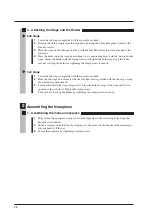
62
Sending a command
Receiving a command
External device
This unit
Receiving format
Sending format
Control processing
Sending a response
(2) Sending Format: [Identification Code] [Command] [Data] [<CR>]
[Identification Code]: 1 lower-case alphabetic character (ASCII code, 1 byte)
[Command]: 3 upper-case alphabetic characters (ASCII code, 3 bytes), [?] (ASCII code, 0x3F)
[?] is added when the [command] portion of a message received by this unit is
short of 3 bytes.
[Data]:
ASCII code, 4 bytes maximum
In case the identification code is an [n], the lower-case alphabetic character (ASCII code, 1
byte) set to [data] will be an error code whose meanings are defined in the table below.
Identification code
o
n
a
s
Specifications
Acknowledging response against a “c“ code
Negative acknowledging response against a “c” or “r” code
Acknowledging response against an “r“ code
Status transmission
Error code
a
b
d
f
4
5
Specifications
Indicates an unregistered command is received
Indicates that data is invalid
Indicates a timeout error occurred during control
Indicates a control command is received while control
is forbidden
The received data exceeded the limit.
Hardware breakdown
Name
Command error
Data Error
Control Timeout Error
Control Forbidden Error
Receive buffer overflow
Hardware error
[<CR>]: Transmission control character (Carriage Return: 0x0D)
6. Communication Sequence
The factory default is the state of (3). If you don't need to connect the external light source and to
send the shutter close command, disable the status output by using the communication command.
(1) When the status output of this unit is disabled;












































